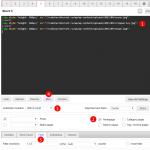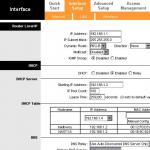Information technology and business. Modern information technologies in small business. Information technology helps to manage business
- CUSTOMER MANAGEMENT
- COMPETITIVENESS
- SMALL BUSINESS
- INFORMATION TECHNOLOGY
The article attempts to show the importance of information technology in successful development small and medium-sized businesses, as well as the composition of their functions and the functioning algorithm.
- The influence of economic factors on architecture and urban planning
- Methodological approaches to assessing the competitiveness of a product, organization and industry
- Human capital as a key factor in the country's competitiveness
- Economic resources. Resource constraints
Today, modern technologies have significantly changed the work of most companies, making changes in its structure and technologies with high productivity. A division was made into micro-enterprises, small, medium and large businesses, as well as transnational corporations (TNCs). And companies began to compete in the struggle for customers (consumers). The market has become bigger and more international. In addition, a new meaning has emerged that was not so important before: information. The saying became very relevant: "Who owns the information, he owns the world." Global markets need new approaches to managing the logistics and production of a company, which can be reduced to management. Information technology has long had a very important place in the management of large enterprises. Especially for solving the problems of transnational companies and large companies, expensive information systems have been created that are designed to simplify the management and ownership of information resources. In these companies, IT solutions are reduced to just one of the software and hardware systems that require significant effort to maintain and develop. One of the leading suppliers software high-level - Microsoft, Oracle, IBM, which offer ready-to-use solutions, the starting price is approximately 20,000 US dollars. This price is more suitable for large companies that want to invest much more in information technology (IT), and in the case of small and medium-sized enterprises, these solutions are not available. It is also worth noting that an important aspect is not only the purchase, but also rather complex services for the maintenance of the service by the enterprise's own efforts. For small businesses, there are practically no integrated solutions now. The reasons for this situation may be a rather complicated model for achieving economic recovery and a low rating of the head of a small company who does not consider it necessary to introduce such a system into the activities of his company.
According to the article "Modern tools for effective management in small business", in order to be in demand in small businesses, an information system must meet certain characteristics:
- Ease of implementation and use;
- There are no features that are not required;
- budget;
- Probability of working on the Internet;
- Russified system interface;
- Technical support by phone in Russian;
- Integration with existing systems.
The main tools that are available for IT implementation and meet the above characteristics can be considered:
- VPN technology;
- Enterprise messaging server (corporate E-mail server);
- CRM system;
- Virtual PBX and multichannel telephone number.
And, I believe that these are absolutely correct characteristics that information technology must meet, since this is quite logical and such characteristics are necessary for effective work in the enterprise.
Network is a generalized name for technologies that allow one or more network connections (a logical network) to be provided over another network (for example, the Internet). Similarly, secure access via the Internet to existing resources on the local network is provided. With this technology, small businesses can afford the following benefits:
- integration of several offices in different cities;
- recruitment of employees, as well as the full-time work of employees who are located in different cities or work at home;
- The manager has access to all documents of his organization anywhere in the world where the Internet is available;
- Working in the internal system from any place where there is an Internet connection, you can also not be afraid for the security of confidential information.
This is just one of the main features that VPN technology can provide for small businesses. As for the cost of this solution, the initial investment in its configuration and connection will be approximately 7,000 rubles. You will have to pay monthly for services (about 600 rubles per month). The technology configuration and implementation period can be extended during the working day. The actual connection process and configuration is of medium complexity, the process is well documented, but there may be technical issues that require expert intervention.
Corporate Messaging Server - This technology is based on a domain name owned by a company that can improve its image and promote its recognition. Within the system Email company each employee of the company is assigned an email address while they work for the company. Thus, email addresses that are known to customers belong to the company, not to a particular employee. In addition, the company, using its own corporate messaging system, has received a very effective tool that promotes quality of service and prevents leaks and finds commercial information. These goals can be achieved through the parameters of the messages that come in via e-mail and the ability to collect all the information received and send it to the specified address, controlled routing. In addition, your own message domain is very beneficial to the corporate image. At this stage of creating an email server company, there are several ways:
- Use the website of the postal service;
- Creating your own server or renting;
- Transfer of mail service to the Google or Yandex website.
The best solution can be considered the last option, when the company sends a professional services messaging server. In addition, based on the site's solution, Yandex has a number of advantages: stability, one of the best in the Russian segment of the Internet, spam and antivirus protection, while it is free and has no additional restrictions. As for the installation and implementation time, you can take one business day. The actual connection process and configuration is of low complexity, the process is well documented, and if you have technical difficulties, you can always ask for free support.
Customer Relationship Management (CRM) is a business strategy for attracting (selecting) and managing customers, aimed at optimizing their value in the long term. CRM implies the presence in the organization of a philosophy and culture focused on the client, aimed at the effectiveness of work in the field of marketing, sales and service. CRM applications make effective customer relationship management possible, provided the business has the right goals, strategy, and culture. Nowadays, if a company wants their work to be efficient, they absolutely need a CRM. The reason is competition, which obliges the company to improve the level of service to its customers.
Currently, the following solutions for small businesses are offered on the CRM systems market:
- Software installed on a PC;
- cloud CRM solution;
- The server system that is used for the corporate server.
One of best solutions for small businesses is one that is based on the principle of cloud systems.
We can fully agree with the marketing.spb.ru website data on the pros and cons of cloud systems.
Advantages of cloud CRM systems:
- theoretically, in cloud systems, the amount of disk space, RAM and the number of processors is absolutely unlimited;
- users do not have to spend their time installing and configuring software, a web browser or smartphone is enough to access cloud services;
- no need to purchase expensive equipment;
- significantly saves time and effort of employees (and sometimes the space occupied by equipment) to perform certain tasks;
- payment is made only for the used computing power and transactions;
- the company does not need to allocate money for infrastructure deployment;
- there is no need to waste time on training, since almost all users know how to use web browsers, as well as Internet services, as a class of services;
- cloud systems are serviced mainly by highly qualified professionals, which in turn has a very positive impact on the quality of software maintenance.
Cons of cloud CRM systems:
- due to constantly emerging security issues, it becomes clear that not all data can still be entrusted to a third-party provider (by the way, this applies not only to storage, but also to the processing of some data);
- the possibility of losing data, for example: due to a technical failure at the service provider;
- the inability to "fasten" additional functions, taking into account the business processes of the enterprise;
- Internet access required. Of course, on the one hand, this is quite convenient, but on the other hand, sometimes the Internet "disappears" from several hours to several days.
In addition to the economic benefits of this technology, it can be said that it is effective, which is quite obvious, since it helps to solve problems such as customer experience control, training, and integration of remote offices. Low-cost solutions, again, depend on the service provider. The technology configuration and implementation period is extended by five business days. The actual connection process and configuration is of medium complexity, the process is well documented, can support service developers, but may require assistance with technical issues at the connection point. This article describes technologies that are easy to understand and apply and that will greatly improve the efficiency and competitiveness of any small business. In other words, these are technical innovations that facilitate the transition of business management skills to a new level. In the next period, we should expect the appearance of completely new systems and services in the domestic market, which will be focused on small and medium-sized enterprises. The basis for these solutions is technical innovation combined with company methodology and efficient information management. But these solutions have distinguishing feature- the company will have to restructure its business processes within the framework of the needs of the system, and not vice versa. In fact, small businesses will be externally influenced and optimized to improve productivity, competitiveness, and overall management efficiency. The novelty of these systems lies in the fact that they are available to small businesses and are being implemented in small businesses through standardization using the management principles necessary to operate in large companies, consultants of external systems and complex systems.
Bibliography
- Modern tools for effective management in small business. V.Yu. Golovin, Ya.D. Gelrud, V.G. Mokhov. 197 c.
- VPN. Wikipedia. [Electronic resource] URL: https://ru.wikipedia.org/wiki/VPN
- Gilyarevsky R.S. Information management: management of information, knowledge, technology: textbook. allowance. - St. Petersburg: Profession, 2009. - 303 p.
- What is CRM? 14 expert definitions [Electronic resource] URL: http://lissianski.narod.ru/crm/crm_definitions.html
- Cloud VS off-the-shelf CRM solutions. What to choose? [Electronic resource] URL: http://www.marketing.spb.ru/soft/crm/out-of-the-box_vs_cloud.htm
Actual problems of aviation and astronautics. Information Technology
V. V. Krinitsyna, L. N. Sidorova supervisor- A.P. Bagaeva Siberian State Aerospace University named after Academician M.F. Reshetnev, Krasnoyarsk
INFORMATION TECHNOLOGIES IN BUSINESS
The role of information technology in business is considered and an analysis of popular programs that automate business processes in enterprises is carried out.
Today, information technology has an impact on all aspects of business. Many firms are involved in the development of information technologies and high profitability of projects in the industry. High-quality information support of any management process economic activity is possible only with the full use of all the achievements of scientific and technological progress. First of all, this concerns the application in the practice of analysis of the latest information technologies: computer equipment, software and telecommunications.
The main task This work is a review of the main programs that automate work in business.
The information system is an information service system for employees of management services and performs technological functions for the accumulation, storage, transmission and processing of information. An automated information system is a collection of information, economic and mathematical methods and models, technical, software, technological tools and specialists, designed to process information and make management decisions. The use of automated information systems is especially important in the management of the financial division of the company. The use of automated information systems allows you to: optimize work plans; make decisions quickly; clearly maneuver financial resources, etc. .
The main component of an automated information system is information technology. The development of information technology has increased the number and level of databases on CD-ROM and online, providing both quantitative, in particular statistical and detailed financial information (for example, Datastream, FAME, Eurostat, nOmIS), and qualitative, such as information on markets and competitors provided by news services (eg Nexis, McCarthy, Reuters Business Briefing). The number of sources of information is growing at an incredible pace, and in the process of finding information, firms rely on the use of online search tools such as Lycos, created by Carnegie Mellon University, WebCrawler, or InfoSeek. The quality of information depends on the quality of the information system and the professionalism of the people responsible for the inputs.
data . The coordinated work of all devices of the information system and their interaction with a person is ensured by the software of the automated workplace of the analyst. Software is divided into general software and functional software. The basic software tools for creating functional software for an analytics workstation are software tools for preparing texts (text editors or word processors), software tools for preparing spreadsheet documents (spreadsheet processors or electronic statements), software tools for automating work on creating and maintaining databases. data, search for the required information for the preparation of various documents. In practice, integrated functional software packages, including a word processor, a spreadsheet processor, a DBMS, as well as a specific command file for setting the software for a specific information processing mode, have become widely used in practice. This allows you to organize the work of an economist at an automated workplace in the “menu” mode with maximum consideration of his professional requirements, combining holistic processing of numbers, texts and graphics, as well as other business information.
Holding financial analysis large organization"manually" does not seem to be efficient, but very important. Currently, there are many programs on the domestic market that allow you to automate the process of organizing and conducting financial analysis.
A comparison was made of three common programs that automate financial analysis: "Audit Expert 4", "INEK-Analyst", "1C: Rarus: Financial Analysis 1.1.". The program "1C-Rarus: Financial Analysis 1.1" is used to: analyze the indicators of the financial and economic activities of the enterprise; formation of arbitrary reporting in the form of tables, graphs and diagrams. The INEC-Analyst program differs significantly from software products of a similar class in that the result of working with it is both a comprehensive financial and economic analysis of the current state of the enterprise, and a well-prepared one that meets the requirements of leading Russian and international financial institutions business-
Section "Information and economic systems"
plan. "Audit Expert 4" ensures the preservation and use in the work of all previously obtained results of financial analysis and all implemented methodological developments. Thanks to this, the program can be successfully used as an optimal solution for analysis financial condition in large companies, in banks and in audit practice. An analysis of the three most common software products in the domestic financial IT market, which allow automating the financial analysis procedure, suggested that the Audit Expert 4 program is more intended for large enterprises due to its great potential.
Any software company designs, develops, and implements complex solutions to automate business processes in enterprises. Automation of business processes is, first of all, automation of management, which allows you to increase the efficiency of each individual employee and the entire organization as a whole, control customers, statistics, accelerate internal and external business processes through a single management environment, control financial
cash flows, forecast demand and plan supply. All the considered programs have similar functions. New technologies provide new sources, methods for delivering and exchanging information, and new ways of manipulating information. As information technology continues to change the nature of transactions and other business transactions, enable chain linking through e-commerce, and facilitate collaboration and alliance building, it is becoming increasingly important to develop the skills to manage information as a resource and a commodity.
1. Titorenko G. A. Automated information technologies in the economy. M., 2008.
2. Grabaurov V. A. Information technologies for managers. M. : Finance and statistics, 2009.
3. URL: http://www.science-education.ru/download/2009/03/2009_03_099.pdf.
© Krinitsyna V. V., Sidorova L. N., Bagaeva A. P., 2010
UDC 669.713.7
O. A. Lishutina, A. A. Paramonova Supervisor - A. P. Bagaeva Siberian State Aerospace University named after Academician M. F. Reshetnev, Krasnoyarsk
INFORMATION TECHNOLOGIES IN THE SPHERE OF MANAGEMENT
The work contains material about information technologies, brief description new information technologies and systems used in the field of management.
The main direction of the restructuring of management and its radical improvement, adaptation to modern conditions there was a massive use of the latest computer and telecommunications equipment, the formation of highly efficient information and management technologies on its basis. New technologies based on computer technology require radical changes organizational structures management, its regulations, personnel potential, system of documentation, fixing and transfer of information. Of particular importance is the introduction of information management, expanding the possibilities for companies to use information resources. The most obvious way to improve flow efficiency labor process is its automation.
The purpose of this work is to study new information technologies in the field of management and to find out the areas of their most effective application.
To achieve this goal, the following tasks were formulated:
1) find information about technological support;
2) identify new information technologies and systems;
3) give a brief description of these technologies;
4) find out in which areas it is best to apply these systems;
5) name the advantages of each of these systems.
The object of research is information technologies and systems in management.
New possibilities of information systems in management appeared in connection with the intensive development of information technologies. The basis of the new information technology is distributed computer technology, "friendly" software and advanced communications .
The concept of new information technology should be based on three main principles: integration, interactivity and flexibility.
Availability own business the dream of many who are tired of working "for their uncle" and getting little money for their work. Own business allows you to get freedom of action and broad prospects in financial and personal plan. Today, the most dynamic business in the field of information technology. A lot of ideas appear, old tricks easily acquire updated features, and the efficiency of previously unprofitable sites increases.
Main idea information business is aimed at a highly developed infrastructure of the Internet, here it is worth adding the transition to trade in goods and services through websites. Another noticeable passion for household preferences. Industrial, commercial enterprises actively use the Internet. Comfortable, interesting leisure, cost-effective, promising project that sells information goods through the site, it seems easier with it.
Advantages and Features
Trade in information goods is attractive for entrepreneurship, but there are exceptions that can turn a profitable idea into a failure on paper. Otherwise, the market will be overflowing with offers, and the prospects will be vague.
Among the advantages it is worth noting:
- Ease of providing information services.
- Constant growth of demand for information projects.
- Minimum initial investment (some directions do not require them at all).
In addition to direct merits, it is easy to find a lot of indirect ones. IT technologies in the current business, subject to the universal availability of the Internet, have completely smoothed the boundaries between Russia and foreign companies/partners. When building a business with the idea of using a global network, distance does not affect its effectiveness in any way.
It is also worth considering the existence of certain requirements for the business system. In the IT field, they are no less important than in other areas. Of interest are:
- High mobility. It concerns decision-making, fulfillment of tasks, analysis of the profitability of the old site.
- Maximum productivity. The requirement applies to employees. They must be proficient in the specific area of IT activity in which they propose to operate.
- Ultimate flexibility. High profitability is possible under the condition of a dynamic business structure, quick connection of new directions, refusal of sites with services, goods that have become unprofitable, bringing a minimum of money.
The idea to shift the focus to the information space of the Internet today has the potential due to the wholesale transition to online. State, commercial organizations, domestic, foreign enterprises - on the Internet, in the opinion of search engines, they all look like "one person". The only difference is the interest in one or the other, shown by the query entered into the line of Internet search sites.
IT Development Trends
Before launching an IT site aimed at online business, it is worth taking a closer look at the previous open projects. Many of them are supposed to be profitable. Is that just how it is? The recent crisis has had a negative impact on online business. A significant number of projects with goods and services disappeared from the market.
Fresh ideas have appeared that can make new projects as sustainable as possible in various crisis phenomena. The following projects have become more active:
- Sale of services. No costs, except for renting a landing page site. That's all there is to it. It is enough to come up with a demanded project and promote the site.
- Online consultations. Spend time communicating with customers. In practice, in fact, it turns out "business on the couch."
- Intermediary services. One of the big ideas. Attractive because of the prospect of developing information projects, with the parallel sale of services, goods, ready-made sites, projects, manuals.
Send your good work in the knowledge base is simple. Use the form below
Students, graduate students, young scientists who use the knowledge base in their studies and work will be very grateful to you.
Similar Documents
Means of computer, communication and organizational technology as a technical basis for providing information technology. Basic computer classification systems. Information technology software in marketing and economics.
lecture, added 04/01/2012
Conditions for increasing the efficiency of managerial work. Basic properties of information technology. System and tools. Classification of information technologies by type of information. The main trends in the development of information technology.
abstract, added 04/01/2010
The role of the management structure in the information system. Examples of information systems. Structure and classification of information systems. Information Technology. Stages of development of information technologies. Types of information technologies.
term paper, added 06/17/2003
Basic concepts and definitions of information technologies, their classification, hardware and software. The role of global information networks and the Internet. The essence of automation of decision-making processes, the use of computer technology.
test, added 12/10/2011
Analysis technical support information systems (microprocessors). Information systems software. Software classification. Training programs primary documents on the example of "1C: Accounting", "1C: Taxpayer".
test, added 07/20/2010
Benefits of using information and communication technologies in education. State and prospects of development of information technologies of BTEU. Tasks of the Department of Distance Educational Technologies, software used.
practice report, added 05/21/2015
Information technologies and systems. Communication of organizations and information systems. Integrated control system industrial enterprises. The possibilities of information technology in business, their impact on the organization and the role of managers in this process.
term paper, added 05/07/2012
The concept, goals and methods of information technology. Criteria and factors of classification. Types of software and properties by type of interactivity, scope, degree of use of computers. Computer facilities and non-computer technologies.
There is one famous saying: "Every science is as much a science as it has mathematicians." Today, something similar can be said about the relationship between business processes and information technology. The vast majority of business processes are only as effective as they are supported by efficient and optimal solutions in terms of IT.
The business has come to this state relatively recently. Just 10-15 years ago, the introduction of IT technologies into business went through stages that sound strange today:
1. "Initial infection of business with information technology." There was a time when IT was really perceived by the subjects of business processes as a toy, a new fashion, a more powerful, but incomprehensible and complex calculator.
I still remember old school accountants who trusted more iron adding machines, and it was a nice time when there was “harmony” between IT specialists (commonly called programmers) and business units. Nobody interfered with each other.
But then young accountants (losers who did not learn how to count on arithmometers and calculators at institutes) began to demand that PCs do not freeze, that the program counts faster, that the printing of forms complies with GOSTs, so that (oh my God!) Two employees can simultaneously work with one database .
IT specialists met the new time with enthusiasm, which infected the management with a willingness to approve new staffing tables and the cost of servers, SCS, modems, and even color laser printers costing as much as a new car.

2. "Taking control." All good things come to an end sometime. The time has come to justify IT budgets, plan IT expenses, and in some places even transfer IT departments to self-sufficiency (then IT outsourcing was born from this). The user became more capricious, he felt like a client (who is always right). And even top managers had such an infantile-consumer attitude towards IT.
Financing was taken under control, but information technology was still included in the business processes of the organization as a fraction of disparate autonomous applications that somehow helped and even accelerated the receipt of data and reports on the management table. Nevertheless, this is the stage of a serious (not experimental) integration of information technologies into the company's business processes.

3. "Data management"- the stage of understanding the role of IT in business as the main tool for good governance information, information flows.
Data is no longer “processed with the help of IT”, data, together with operations on them (described in business processes) - form information system, and the IT infrastructure ensures efficient operation of enterprise information systems in the interests of the business.

4. "Maturity"- the stage to which enterprises have been going for years, and which now should be implemented within a few months after the start of the business unit, and even better, a few months before the start.
Maturity is when all the information flows that form an information system are just a reflection of the structure of the enterprise and all its business processes.
That is, IT ceases to be just a tool-stick (before, even the term was “crutch”). The role of information technology in business has changed. Now IT is a business, an integral part of it, earning not money to buy servers, but in general ALL the money for the company.
At this stage, top managers can no longer "transfer arrows" to the system administrator (or IT manager) when tasks are not completed due to broken email.
And for an IT manager, metrics and KPIs are tied to the results of the entire company, and not just to the uptime of servers. This is the stage of shared responsibility and understanding that IT (information technology) is a generic term for business technology.
Next stage is when IT generates new business models through global penetration and comprehensive information access. It is possible that in 10 years it will be completely inappropriate to ask whether there is a business and business processes outside the Internet (or whatever it will be called then).





